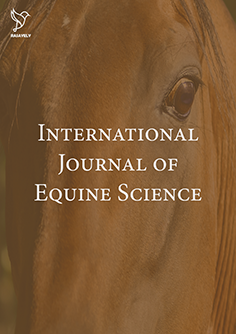Evaluating the Feeding Management and Housing Conditions of Horses in Lesotho
Horse Feeding and Housing in Lesotho
Keywords:
horse, evaluation, feeding, housingAbstract
Lesotho is proud of its horses, and there are many skilled riders in rural areas. A cross-sectional study was conducted from September to December 2020, involving 321 horse owners. The objective of the study was to assess the housing and feeding management of horses in Lesotho. The evaluation of feeding management focused on production systems, types of commercial feeds, and access to water. The housing conditions assessment was based on the horses' environment. The majority of horses were kept under a semi-enclosed framework. In rural, semi-urban, and urban areas, grazing alone failed to meet the nutritional needs of horses by 70.1%, 89.4%, and 85.1%, respectively. Regarding housing, the majority of horses were tied, while only a few were kept in clean stalls (8.2%, 3.1%, and 4.1%) with proper bedding. Based on the data obtained in this study, it can be concluded that the feeding and housing conditions for horses in Lesotho are inadequate. Therefore, horse owners should receive training on how to improve the feeding and housing practices for their horses.
References
Lekota TA. The state of the Basotho Pony in Lesotho 2001. https://www.fao.org/3/Y3970E/y3970e08.htm (accessed August 7, 2023).
Rwelamira JK. Economic aspects of draught animal power 1998:9–10.
McLean AN, McGreevy PD. Ethical equitation: Capping the price horses pay for human glory. Journal of Veterinary Behavior 2010;5:203–9. https://doi.org/10.1016/j.jveb.2010.04.003.
Bonde M. Welfare assessment in a commercial sow herd - Development, evaluation and report of the method. Ph.D. Thesis. The Royal Veterinary and Agricultural University, 2003.
Davidson H. The impact of nutrition and feeding practices on equine behaviour and welfare 2002.
Fraser A, Broom D. Farm animal behaviour and welfare. 3rd Edition. London: Bailliere Tindall; 1990.
Rivera E, Benjamin S, Nielsen B, Shelle J, Zanella AJ. Behavioral and physiological responses of horses to initial training: the comparison between pastured versus stalled horses. Applied Animal Behaviour Science 2002;78:235–52. https://doi.org/10.1016/S0168-1591(02)00091-6.
Chaplin SJ, Gretgrix L. Effect of housing conditions on activity and lying behaviour of horses. Animal 2010;4:792–5. https://doi.org/10.1017/S1751731109991704.
Connysson M, Rhodin M, Jansson A. Effects of horse housing system on energy balance during post-exercise recovery. Animals (Basel) 2019;9:976. https://doi.org/10.3390/ani9110976.
Cooper JJ, Albentosa MJ. Behavioural adaptation in the domestic horse: potential role of apparently abnormal responses including stereotypic behaviour. Livestock Production Science 2005;92:177–82. https://doi.org/10.1016/j.livprodsci.2004.11.017.
Buckley P. Epidemiological studies of health and performance in Pony Club horses. Ph.D. Thesis. School of Veterinary Science. The University of Queensland, 2008.
Mellor D, Love S, Reeves M, Gettinby G, Reid S. A demographic approach to equine disease in the northern UK through a sentinel practice network. Epidemiologie Sante Animaux 1997:31–2.
Thorne JB, Goodwin D, Kennedy MJ, Davidson HPB, Harris P. Foraging enrichment for individually housed horses: Practicality and effects on behaviour. Applied Animal Behaviour Science 2005;94:149–64. https://doi.org/10.1016/j.applanim.2005.02.002.
Kompi P, Molapo S, Nts'aoana M. Farmers knowledge and control practices on gastrointestinal parasites of horses in Maseru District, Lesotho. Advances in Animal and Veterinary Sciences 2021;9:715–21. https://doi.org/10.17582/journal.aavs/2021/9.5.715.721.
Upjohn MM, Shipton K, Pfeiffer DU, Lerotholi T, Attwood G, Verheyen KLP. Cross-sectional survey of owner knowledge and husbandry practices, tack and health issues affecting working horses in Lesotho. Equine Vet J 2012;44:310–8. https://doi.org/10.1111/j.2042-3306.2011.00442.x.
Murray J-AMD, Bloxham C, Kulifay J, Stevenson A, Roberts J. Equine nutrition: A survey of perceptions and practices of horse owners undertaking a massive open online course in equine nutrition. Journal of Equine Veterinary Science 2015;35:510–7. https://doi.org/10.1016/j.jevs.2015.02.005.
Harris PA. Feeds and feeding in the United Kingdom. In: Robinson N, editor. Therapy in Equine Medicine, Washington: W.B. Saunders; 1997, p. 121–4.
Harris PA. Developments in equine nutrition: comparing the beginning and end of this century. The Journal of Nutrition 1998;128:S2698–703. https://doi.org/10.1093/jn/128.12.2698S.
Novak S, Shoveller A, Warren L. Nutrition and feeding management for horse owners. Alberta, Canada: Alberta Agriculture and Rural Development; 2008.
Macleay C. The feeding and management practices of Australian horse owners. Dissertation. Charles Sturt University, 2018.
Thompson K, Clarkson L, Riley C, van den Berg M. Horse-keeping practices in Australia: findings from a national online survey of horse owners. Australian Veterinary Journal 2017;95:437–43. https://doi.org/10.1111/avj.12639.
McGowan TW, Pinchbeck G, Phillips CJC, Perkins N, Hodgson DR, McGowan CM. A survey of aged horses in Queensland, Australia. Part 1: management and preventive health care. Aust Vet J 2010;88:420–7. https://doi.org/10.1111/j.1751-0813.2010.00637.x.
Mezgebu T, Tafess K, Tamiru F. Prevalence of gastrointestinal parasites of horses and donkeys in and around Gondar Town, Ethiopia. Open Journal of Veterinary Medicine 2013;3(6):267–72.
Leme DP, Parsekian ABH, Kanaan V, Hötzel MJ. Management, health, and abnormal behaviors of horses: A survey in small equestrian centers in Brazil. Journal of Veterinary Behavior 2014;9:114–8. https://doi.org/10.1016/j.jveb.2014.01.004.
Søndergaard E, Ladewig J. Group housing exerts a positive effect on the behaviour of young horses during training. Applied Animal Behaviour Science 2004;87:105–18. https://doi.org/10.1016/j.applanim.2003.12.010.
AWIN. AWIN welfare assessment protocol for horses 2015.
Saastamoinen M, Särkijärvi S, Hyyppä S. Reducing Respiratory Health Risks to Horses and Workers: A Comparison of Two Stall Bedding Materials. Animals (Basel) 2015;5:965–77. https://doi.org/10.3390/ani5040394.
Downloads
Published
Issue
Section
License
Copyright (c) 2023 Moleboheng J. Bolibe, Setsumi Molapo

This work is licensed under a Creative Commons Attribution 4.0 International License.
Authors retain the copyright of their manuscripts, and all Open Access articles are distributed under the terms of the Creative Commons Attribution License, which permits unrestricted use, distribution, and reproduction in any medium, provided that the original work is properly cited.

